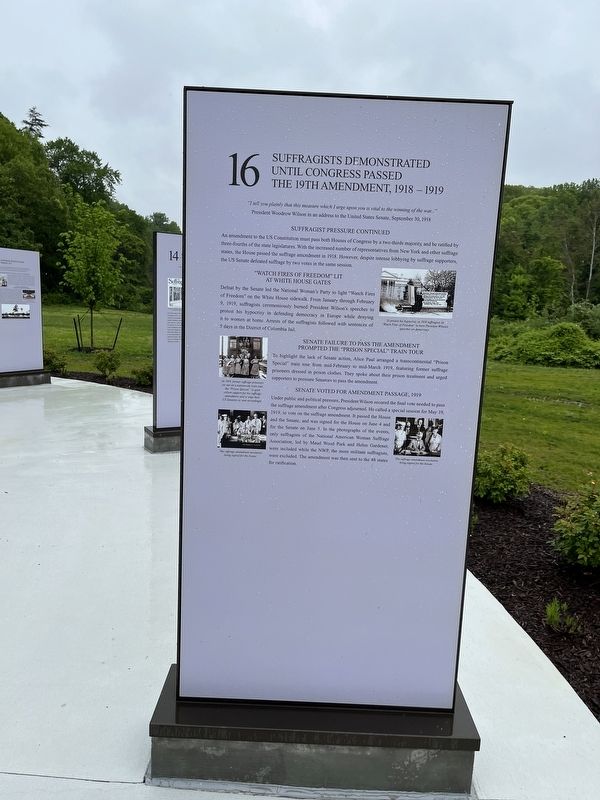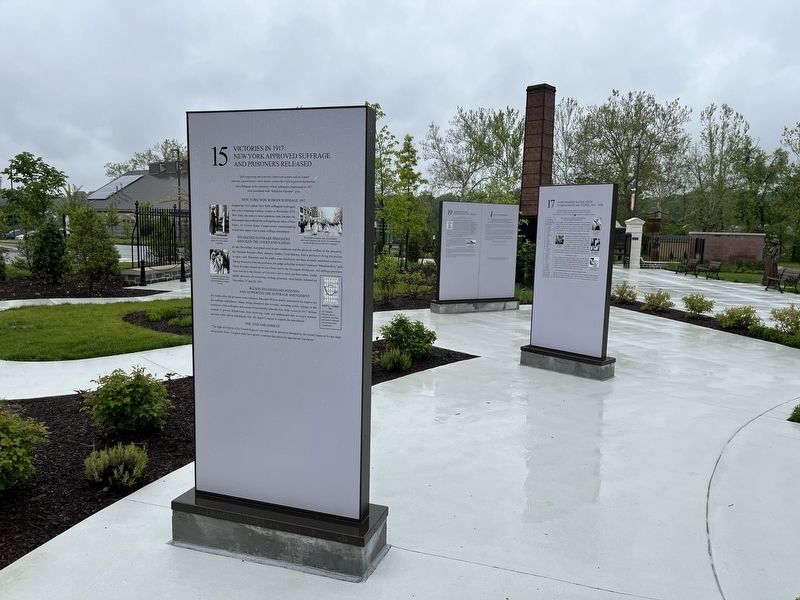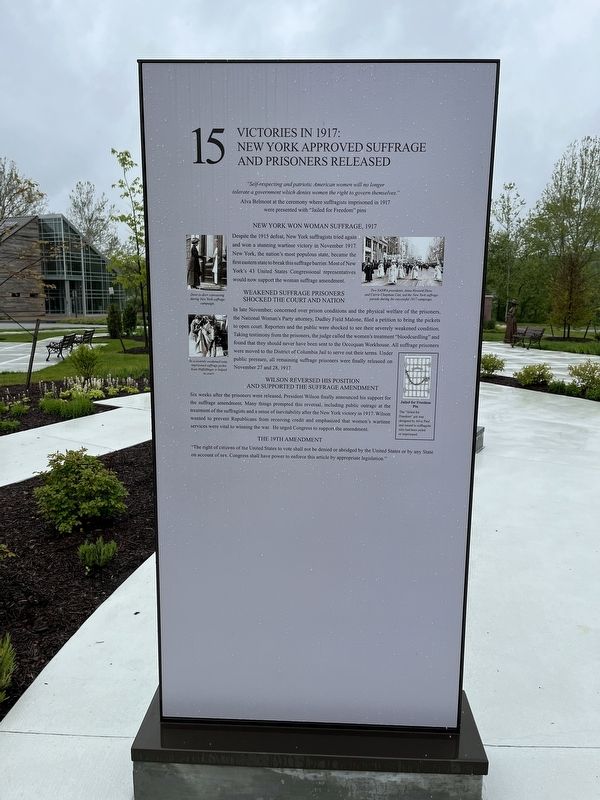Lorton in Fairfax County, Virginia — The American South (Mid-Atlantic)
Victories in 1917 / Suffragists Demonstrated Until Congress Passed the 19th Amendment
Victories in 1917: New York Approved Suffrage and Prisoners Released
"Self-respecting and patriotic American women will no longer tolerate a government which denies women the right to govern themselves."
Alva Belmont at the ceremony where suffragists imprisoned in 1917 were presented with "Jailed for Freedom" pins
New York Won Woman Suffrage, 1917
Despite the 1915 defeat, New York suffragists tried again and won a stunning wartime victory in November 1917. New York, the nation's most populous state, became the first eastern state to break this suffrage barrier. Most of New York's 43 United States Congressional representatives would now support the woman suffrage amendment.
Weakened Suffrage Prisoners Shocked the Court and Nation
In late November, concerned over prison conditions and the physical welfare of the prisoners, the National Woman's Party attorney, Dudley Field Malone, field a petition to bring the pickets to open court. Reporters and the public were shocked to see their severely weakened condition. Taking testimony from the prisoners, the judge called the women's treatment "bloodcurdling" and found that they should never have been sent to the Occoquan Workhouse. All suffrage prisoners were moved to the District of Columbia Jail to serve out their terms. Under public pressure, all remaining suffrage prisoners were finally released on November 27 and 28, 1917.
Wilson Reversed His Position and Supported the Suffrage Amendment
Six weeks after the prisoners were released, President Wilson finally announced his support for the suffrage amendment. Many things prompted this reversal, including public outrage at the treatment of the suffragists and a sense of inevitability after the New York victory in 1917. Wilson wanted to prevent Republicans from receiving credit and emphasized that women's wartime services were vital to winning the war. He urged Congress to support the amendment.
19th Amendment
"The right of citizens of the United States to vote shall not be denied or abridged by the United States or by any State on account of sex. Congress shall have power to enforce this article by appropriate legislation."
[Sidebar:]
Jailed for Freedom Pin
The "Jailed for Freedom" pin was designed by Alice Paul and issued to suffragists who had been jailed or imprisoned.
[Captions:]
Door to door canvassing during New York suffrage campaign.
In a severely weakened state, imprisoned suffrage picket Kate Heffelfinger is helped to court.
Two NASWA presidents, Anna Howard Shaw and Carrie

Photographed By Devry Becker Jones (CC0), May 6, 2022
2. Suffragists Demonstrated Until Congress Passed the 19th Amendment side of the marker
Suffragists Demonstrated Until Congress Passed the 19th Amendment, 1918-1919
"I tell you plainly that this measure which I urge upon you is vital to winning of the war."
President Woodrow Wilson in an address to the United States Senate, September 30, 1918
Suffragist Pressure Continued
An amendment to the US Constitution must pass both Houses of Congress by a two-thirds majority, and be ratified by three-fourths of the state legislatures. With the increased number of representatives from New York and other suffrage states, the House passed the suffrage amendment in 1918. However, despite intense lobbying by suffrage supporters, the US Senate defeated suffrage by two votes in the same session.
"Watch Fires of Freedom" Lit at White House Gates
Defeat by the Senate led the National Woman's Party to light "Watch Fires of Freedom" on the White House sidewalk. From January through February 9, 1919, suffragists ceremoniously burned President Wilson's speeches to protest his hypocrisy in defending democracy in Europe while denying it to women at home. Arrests of the suffragists followed with sentences of 5 days in the District of Columbia Jail.
Senate Failure to Pass the Amendment

Photographed By Devry Becker Jones (CC0), May 6, 2022
3. The three last markers in the display are shown.
To highlight the lack of Senate action, Alice Paul arranged a transcontinental "Prison Special" train tour from mid-February to mid-March 1919, featuring former suffrage prisoners dressed in prison clothes. They spoke about their prison treatment and urged supporters to pressure Senators to pass the amendment.
Senate Voted for Amendment Passage, 1919
Under public and political pressure, President Wilson secured the final vote needed to pass the suffrage amendment after Congress adjourned. He called a special session for May 19, 1919, to vote on the suffrage amendment. It passed the House and the Senate, and was signed for the House on June 4 and for the Senate on June 5. In the photographs of the events, only suffragists of the national american Woman Suffrage Association, led by Maud Wood Park and Helen Gardener, were included while the NWP, the more militant suffragists, were excluded. The amendment was then sent to the 48 states for ratification.
[Captions:]
To protest his hypocrisy, in 1919 suffragists lit "Watch Fires for Freedom" to burn President Wilson's speeches on democracy.
In 1919, former suffrage prisoners set out on a nationwide train tour, the "Prison Special," to gain citizen support for the suffrage amendment and to urge their US Senators to vote accordingly.
The suffrage amendment resolution being signed for the House.
The suffrage amendment resolution being signed for the Senate.
Erected 2021 by Turning Point Suffragist Memorial Association. (Marker Number 15/16.)
Topics and series. This historical marker is listed in these topic lists: Civil Rights • Government & Politics • Law Enforcement • Railroads & Streetcars • Women. In addition, it is included in the Former U.S. Presidents: #28 Woodrow Wilson series list. A significant historical date for this entry is February 9, 1919.
Location. 38° 40.931′ N, 77° 15.168′ W. Marker is in Lorton, Virginia, in Fairfax County. Marker is on Lorton Road, one mile south of Ox Road (Virginia Route 123), on the left when traveling east. Touch for map. Marker is at or near this postal address: 9751 Ox Rd, Lorton VA 22079, United States of America. Touch for directions.
Other nearby markers. At least 8 other markers are within walking distance of this marker. Worsening Conditions / Violent Repression (here, next to this marker); Hard-Fought Ratification Campaigns in the States / The Continued Struggle for Voting Rights (here, next to this marker); The Suffrage Campaign in Wartime / Suffrage Pickets Chose Prison (a few steps from this marker); "Forward Into Light," Toward Equality, 1920 - Present / The 19th Amendment (a few steps from this marker); "Forward Out of Darkness" / Issuing a Call for Women's Rights (a few steps from this marker); Building a Political Movement / Testing Constitutional Amendments (a few steps from this marker); 1916 / Nonviolent Protests at the White House Gates (a few steps from this marker); Suffrage Campaigns State By State / New Leaders, New Approaches (a few steps from this marker). Touch for a list and map of all markers in Lorton.
Credits. This page was last revised on November 6, 2023. It was originally submitted on May 7, 2022, by Devry Becker Jones of Washington, District of Columbia. This page has been viewed 83 times since then and 15 times this year. Photos: 1, 2, 3. submitted on May 7, 2022, by Devry Becker Jones of Washington, District of Columbia.
